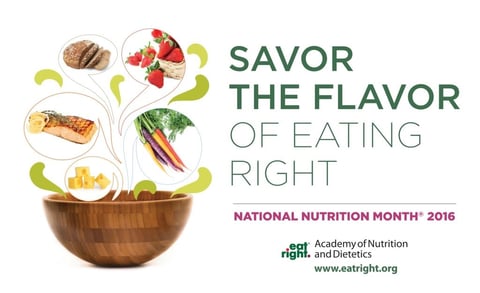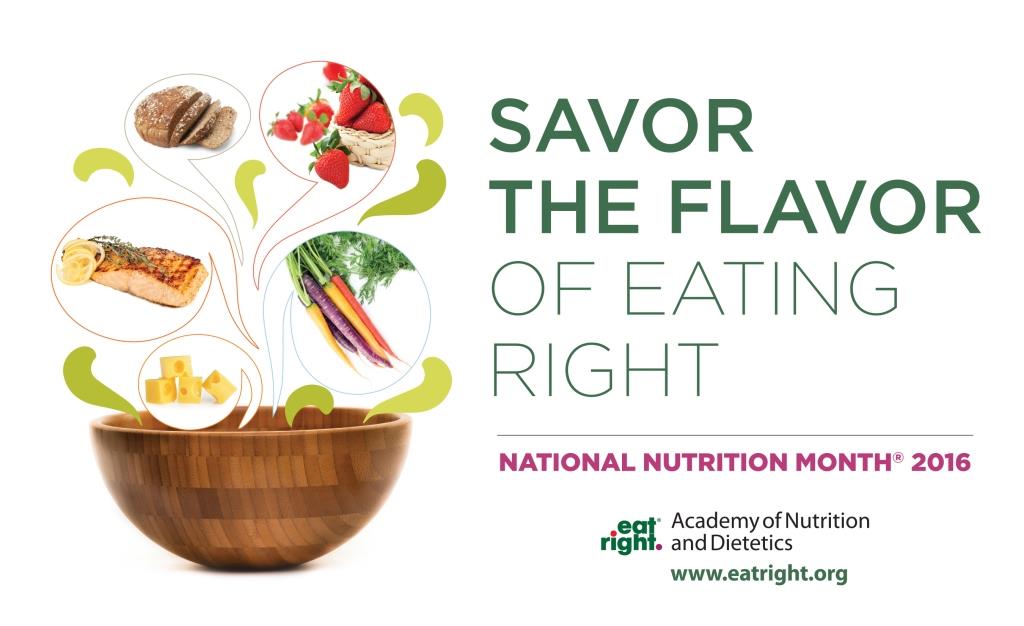 All too often I see recipes that pack in a lot of really healthy ingredients but lack in the taste category. I also come across diet plans that restrict the foods people love and also those that allow them to swing by the fast food window to get a meal loaded with calories, sodium, and fat to eat on the car ride home. The theme of this year’s National Nutrition Month is “Savor the Flavor of Eating Right.” It is a theme that can be easily overlooked, but in reality, it is a simple statement that addresses some of America’s biggest problems—a poor relationship with food and mindless eating.
All too often I see recipes that pack in a lot of really healthy ingredients but lack in the taste category. I also come across diet plans that restrict the foods people love and also those that allow them to swing by the fast food window to get a meal loaded with calories, sodium, and fat to eat on the car ride home. The theme of this year’s National Nutrition Month is “Savor the Flavor of Eating Right.” It is a theme that can be easily overlooked, but in reality, it is a simple statement that addresses some of America’s biggest problems—a poor relationship with food and mindless eating.
This month the Academy of Nutrition and Dietetics (AND) encourages us to improve this relationship by taking it slow and focusing on the entire experience food can offer us. As the AND states, eating is about more than just the food we chew on, it is about how, when, why, and where we are eating. We should be enjoying meals as a part of family traditions, using food as an opportunity to experience flavors from different cultures, learning how to cook new recipes with a spouse, or even to just simply pay attention to the complex flavors of food.
What we eat is of course meant to offer us nourishment, something that is vital to our existence, but it can also be one of the greatest pleasures in life. Merging these two aspects can help you rediscover healthy eating in a new light. Use this month to start introducing healthy and delicious recipes or food habits into your daily life.
Here are a few ideas to help you get started:
 Grow a vegetable garden this summer. You’ll find you appreciate that salad, or the vegetables in your fajitas so much more if you prepared them starting from a seed. Plus, vegetables are a nutritious, colorful, and low-calorie addition to your meals.
Grow a vegetable garden this summer. You’ll find you appreciate that salad, or the vegetables in your fajitas so much more if you prepared them starting from a seed. Plus, vegetables are a nutritious, colorful, and low-calorie addition to your meals.
- Be mindful of what you put on your plate and use smaller dishes and utensils to help you eat at a slower pace. You’ll recognize that all of the flavors in the dish will be more articulated, you’ll get more satisfaction, and you’ll recognize that you are full before you get a second helping!
- Cooking at home can also improve your appreciation of food and amp up the enjoyment factor. When you cook at home, it is also much easier to throw in some extra veggies and control the sodium and fat. It can be a lot of fun to try out new recipes, especially when you share the experience with a loved one...not to mention it is usually much cheaper than dining out!
- Drink water, tea, or another calorie-free beverage throughout the meal to slow down the eating process. It takes about 20 minutes for your stomach to register it is full, so when you take the time to sip some water throughout the meal or have a bit of conversation, you’ll find that you are full right around the time you finish your plate.
- If you find that you are fighting the mid-morning munchies every day, pack a healthy snack. Having healthy snacks on hand like apples, tangerines, 100-calorie packs of nuts, string cheese, or a 0% Greek yogurt can prevent overeating later on in the day.
- Participate in a local food co-op or visit farmers markets to support local agriculture and discover fresh new produce to use.
Read More:
- National Nutrition Month goes Back to the Basics with Healthy Eating
- What Did You Do for National Fiber Focus Month?
- Encourage Healthy Habits for Childhood Obesity Month
- Heart Health Month: Say No to High-Sodium Foods for Your Loved Ones
National Nutrition Month 2016 Resources and Graphic:
National Nutrition Month. Academy of Nutrition and Dietetics, 3 Mar. 2016.
Image credit: © citalliance / 123RF Stock Photo; modified by text overlay.




